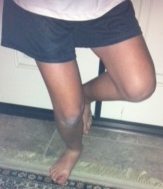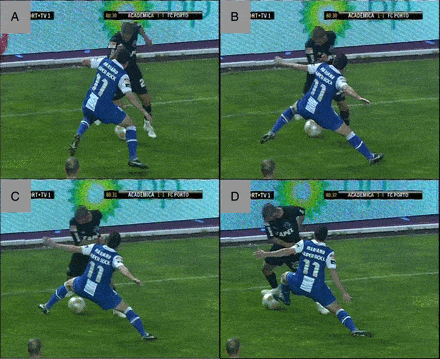Players, coaches and families take notice: after further video review, two common movements put athletes at high risk for soccer Anterior Cruciate Ligament (ACL) injuries.
Articles in the April 2015 British Journal of Sports Medicine (males only) and May/June 2015 Sports Health (males/females) reviewed videos of soccer ACL injuries.
Both confirmed that landing off-balance on one leg puts players at high risk.
We’ve known this for quite a while.
These studies did add a new twist as certain defensive movements may also be a common culprit.
Around 3/4 of all soccer ACL tears were found to occur when the injured athlete was defending. The Sports Health group found that females were more likely to be defending when they injured their ACL.
Now, forwards who are reluctant (or lazy) to come back on defense may be silently rejoicing at this news.
For those who actually play defense, let’s take a deeper look at the risky situations:
- Tackling to separate the ball from an opponent.
- Often requires last minute adjustments in body position and technique
- Cutting to track an opponent
- Pressing situations where defending player typically made sidestep cut in order to reach ball or tackle an opponent
In addition to defensive play, off-balance landing on one foot was also a common culprit:
- Regaining balance after kicking
- Landing after heading
In both situations, the injured knee was more apt to be in certain “danger position”:
Valgus (knee bent inward towards the opposite knee)
Extended(knee near of fully in a straight position)

Soccer ACL Injuries: “Danger position”: inward movement (valgus) and straighter right knee relative to right hip and ankle.
So, what teaching points can be made to reduce soccer ACL injuries in younger players?
No, we are not going to give any excuses justifying not playing defense.
But there should be no excuse to use evidence-based soccer ACL injury reduction programs.
Better to invest 15 minutes per practice than the minimum 6-9 months (after surgery) for rehab after an ACL tear.
What are parts of an soccer ACL injury reduction program?
- General postural and neuromuscular control of the core and lower extremities;
- Footwork and running technique during changes of direction on defensive, mimicking the pressing situation;
- Maintaining balance during shooting, passing and ball clearing;
- Jumping and landing technique during heading duels;
- Promoting fair play in order to avoid fierce tackling from behind
Thankfully, there are several evidence-based programs readily found at no charge:
- Lurie Children’s Institute for Sports Medicine Knee Injury Prevention Program (KIPP)
- Santa Monica Sports Medicine Foundation PEP Program
- Sportsmetrics ACL Injury Prevention Program
- All these can be done as a 10-15 warm-up program before practices
Players and parents, do you ask your coaches and trainers to include these training techniques? Coaches and trainers, are you adding value to your program by emphasizing injury prevention? Any other drills that you think would contribute to proper balance, defensive postures, landing and tackling techniques?


